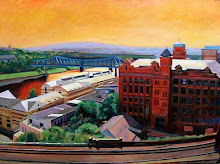All very much to my taste.
While it might have been more comfortable to have done all of this in sunshine, much of our sightseeing was done in a gently blowing mist. But this certainly gave the distinctly Romantic remains of a tin mine, with its nearby chimney , a charming ghostly quality as it loomed over us out of the mist.
Later, parking by the road, we walked up a country track then out onto the moor to find Men-an-Tol. This is the relic which looks like 101 - three standing stones in a line, the two end ones straight upright, the middle one round, with a round hole in it.
The very worthy and interested Victorians messed around with these stones, as they did with many others, so it's unclear whether there was any astronomical alignment. It did cross my mind that it might be digital machine code, but the vision of Erich Von Daniken leered at me and I dropped the idea.
Legend has it that a sick person passed entirely through the hole will be cured. Both Buddy K and I stuck our feet through but I'm here to tell you that it didn't work. This is not a cure for planta fasciitis. But then we didn't actually pass bodily through the hole, so who knows...
Further up the track and in another field, is Men Scryfa. It's an eerie feeling standing in the middle of a field in a dense fog, with nothing but each other and a tall inscribed stone for company.
The stone is said to be the height of the fallen warrior whose death it commemorates, but considering some of it is below ground such that the inscription is partly hidden, he must have been quite a giant. Buddy K and I are about 5 ft 9 and the stone rose almost a foot above us.Back on the road, there was another site not too far away. The probably very famous Lanyon Quoit. The Victorians stood these up too, and one was broken, so the monument is no longer as tall as it once was. But it's still a very impressive construction.












No comments:
Post a Comment